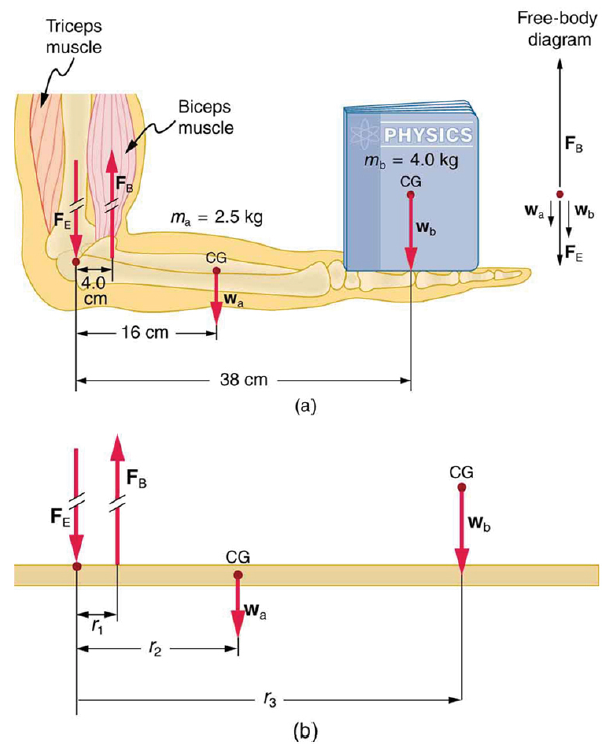Search results

(a) The figure shows the forearm of a person holding a book. The biceps exert a force FB to support the weight of the forearm and the book. The triceps are assumed to be relaxed. (b) Here, you can view an approximately equivalent mechanical system with the pivot at the elbow joint
Strategy
There are four forces acting on the forearm and its load (the system of interest). The magnitude of the force of the biceps is FB, that of the elbow joint is FE, that of the weights of the forearm is wa , and its load is wb. Two of these are unknown FB, so that the first condition for equilibrium cannot by itself yield FB . But if we use the second condition and choose the pivot to be at the elbow, then the torque due to FE is zero, and the only unknown becomes FB .
Solution
The torques created by the weights are clockwise relative to the pivot, while the torque created by the biceps is counterclockwise; thus, the second condition for equilibrium (net τ = 0) becomes
Note that sin θ = 1 for all forces, since θ = 90º for all forces. This equation can easily be solved for FB in terms of known quantities,yielding. Entering the known values gives
which yields
Now, the combined weight of the arm and its load is known, so that the ratio of the force exerted by the biceps to the total weight is
Discussion
This means that the biceps muscle is exerting a force 7.38 times the weight supported.
Reference : OpenStax College,College Physics. OpenStax College. 21 June 2012.
http://openstaxcollege.org/textbooks/college-physics
Creative Commons License : http://creativecommons.org/licenses/by/3.0/
In physics, the angular velocity is defined as the rate of change of angular displacement and is a vector quantity (more precisely, a pseudovector) which ... more
Parallel axis theorem ( Huygens –Steiner theorem) , can be used to determine the mass moment of inertia or the second moment of area of a rigid body about ... more
(a) Calculate the buoyant force on 10,000 metric tons (1.00×10 7 kg) of solid steel completely submerged in water, and compare this with the steel’s weight.
(b) What is the maximum buoyant force that water could exert on this same steel if it were shaped into a boat that could displace 1.00×10 5 m 3 of water?
Strategy for (a)
To find the buoyant force, we must find the weight of water displaced. We can do this by using the densities of water and steel given in Table [insert table #] We note that, since the steel is completely submerged, its volume and the water’s volume are the same. Once we know the volume of water, we can find its mass and weight
First, we use the definition of density to find the steel’s volume, and then we substitute values for mass and density. This gives :
Because the steel is completely submerged, this is also the volume of water displaced, Vw. We can now find the mass of water displaced from the relationship between its volume and density, both of which are known. This gives:
By Archimedes’ principle, the weight of water displaced is m w g , so the buoyant force is:
The steel’s weight is 9.80×10 7 N , which is much greater than the buoyant force, so the steel will remain submerged.
Strategy for (b)
Here we are given the maximum volume of water the steel boat can displace. The buoyant force is the weight of this volume of water.
The mass of water displaced is found from its relationship to density and volume, both of which are known. That is:
The maximum buoyant force is the weight of this much water, or
Discussion
The maximum buoyant force is ten times the weight of the steel, meaning the ship can carry a load nine times its own weight without sinking.
Reference : OpenStax College,College Physics. OpenStax College. 21 June 2012.
http://openstaxcollege.org/textbooks/college-physics
Creative Commons License : http://creativecommons.org/licenses/by/3.0/
Contact mechanics is the study of the deformation of solids that touch each other at one or more points. Hertzian contact stress refers to the localized ... more
In solid mechanics, torsion is the twisting of an object due to an applied torque. The torsion constant is a geometrical property of a bar’s cross-section ... more
In mathematical physics, equations of motion are equations that describe the behaviour of a physical system in terms of its motion as a function of ... more
Torque, moment or moment of force (see the terminology below) is the tendency of a force to rotate an object about an axis. In addition to the tendency to ... more
A collision is an isolated event in which two or more moving bodies (colliding bodies) exert forces on each other for a relatively short time. Collision is ... more
In solid mechanics, torsion is the twisting of an object due to an applied torque. The torsion constant is a geometrical property of a bar’s cross-section ... more
...can't find what you're looking for?
Create a new formula
Calculate the force the biceps muscle must exert to hold the forearm and its load as shown in the figure below, and compare this force with the weight of the forearm plus its load. You may take the data in the figure to be accurate to three significant figures.